From The Botanist in the Kitchen, where botany meets the cutting board blog
by Katherine A. Preston
The Beet Goes On
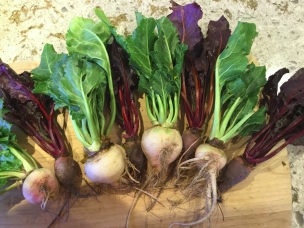 | | Red and white beets |
Throughout two years of dating and
our first six months of marriage, my husband and I had never discussed
our feelings about beets. Then again, I had never made beets for him
before. When I did, they were meant to bulk up a brimming vat of stew
that would feed us every night for a week. In my husband’s version of
the story, it lasted for three weeks. “I hope you like beets,” I
announced that evening. “I may have added too many.”
Whether you
love or hate beets, it is probably because they taste like dirt. Some
people (my husband) can’t get over the flavor, and others can’t get
enough of it. Some people experience beeturia, the appearance of bright
red or hot pink urine after they eat red beets. Maybe this sight
unsettles you. Or maybe you embrace the opportunity to track the
transit of beet pigments through your body. You may admire their lovely
rings and be inspired by the rich and brilliant colors that beets bring
to salads. Or you might have picked up a lifelong aversion after too
many canned pickled beets on a school lunch tray. Beets are a pretty
polarizing vegetable. If you are among the haters, I’m going to do my
best to turn the beet around for you.
Why beets taste like dirt
Beets
taste like dirt because they contain a compound called geosmin (meaning
“dirt smell”). Geosmin is produced in abundance by several organisms
that live in the soil, including fungi and some bacterial species in
the genus Streptomyces. Humans are extremely sensitive to low
concentrations of geosmin – so much so that we can smell it floating in
the air after rain has stirred it up from the soil (Maher &
Goldman, 2017). While people generally like that rain-fresh scent in
the air, it’s less welcome elsewhere. For example, we perceive it as an
off taste in water drawn from reservoirs with a lot of
geosmin-producing cyanobacteria. In wines, geosmin contributes to cork
taint.
What is the origin of geosmin in beets? It has been
surprisingly difficult to show that beets make their own geosmin rather
than take it up from the soil or from geosmin-producing microbes that
live on or in their tissues. One approach has been to use artificial
selection to try to change geosmin levels. The logic is that if
different beet strains can be bred to have higher or lower levels of
geosmin, then geosmin may be under the control of the beet’s own genes
and not simply subject to soil conditions or external microbes. A
recent study (Maher & Goldman, 2017) reported exactly that:
successful selection for high- and low-geosmin strains. The authors
pointed out, however, that they could have been selecting for other
traits that would influence geosmin levels indirectly, such as skin
permeability or the tendency to host microbes. To address that
possibility, the researchers followed up their selection study by
growing several beet varieties under sterile conditions and measuring
their geosmin concentration. They verified the sterile conditions by
detecting no microbial DNA in their samples, and they found that beets
nevertheless produced geosmin in the absence of any microbial
contamination (Maher & Goldman, 2018). So there is pretty good
evidence that beets make geosmin, but what does it do for the beet
plants? That, we still don’t know.
Everyone agrees that beets
taste like dirt, but why do some of us seek out that flavor while
others avoid it? There are many scents and flavors that attract or
repel, depending on their context. Parmesan cheese smells like vomit,
white pepper smells like wet dog, and expensive Italian truffles smell
like feet. Geosmin flavor in water or wine is off putting because it
indicates contamination (harmless as it may be), but we love it after a
gentle rain because it belongs there. Beet lovers welcome geosmin as a
normal flavor component of beets. Do beet haters, by contrast,
attribute it to something unhealthy? It’s tempting to associate the
mineral dirt flavor of beets with their bloody appearance. That could
certainly explain the aversion. Fortunately, there is a way to reduce
that particular flavor note: geosmin is odorless in acid (Gerber &
Lechevalier 1965), so vinegar-pickled beets or fermented beet kvass
will taste much less like dirt.
Why (some) beets are red
Red
beets – and even golden ones – have a hot brightness to their color
that is not found in roses or tomatoes or radishes. Beet stems and
roots appear almost fluorescent, as do the colorful parts of most of
their relatives, including cactus flowers, rhubarb stalks,
bougainvilleas, and four o’clocks. Chard is just a variety of beet, and
so its leaf ribs also glow red, pink, and yellow. All of these plants
belong to the order Caryophyllales and they use pigments called
betalains, named, or course, for beets (Beta vulgaris).
Betalains are a class of pigments that includes the red-to-violet
betacyanins that dominate red beets and the yellow-orange betaxanthins
that color golden ones.
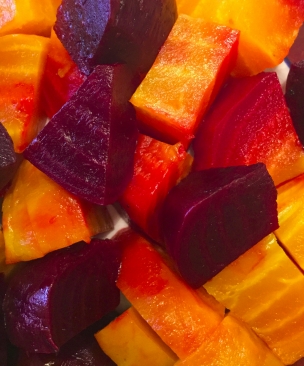
Betalains
are special; they are found in no other flowering plant group except
the Caryophyllales, and they never ever occur alongside the
anthocyanins, the class of pigments responsible for most reds, purples,
and blues in every other plant group.
Plants make pigments for
many reasons – signaling to pollinators and dispersers, protecting
cells from UV radiation, controlling oxidative damage, etc. – but it’s
not yet clear whether betalains confer a distinct evolutionary
advantage that explains their presence in the Caryophyllales. Betalains
have recently been associated with gray mold resistance (Polturak et
al., 2017), and they may help protect plants from salt stress (Davies
et al., 2018), but no clear advantage has emerged. Two families in the
group, including the carnation family, have given up betalains and
reverted to anthocyanin production, which suggests that betalains are
not always favored evolutionarily.
 | | Relationships among edible species in the Amaranthaceae, which is part
of the larger order Caryophyllales. Relationships and characters based
on Judd et al. (2nd ed) and the Angiosperm Phylogeny Website ver. 12. |
Betalains
and anthocyanins are never found together in nature apparently because
their biosynthesis represents mutually exclusive pathways (Brockington
et al., 2015; Lopez‐Nieves et al., 2017). The two classes of pigments
are made from different amino acids (anthocyanins from phenylalanine
and betalains from tyrosine) and there is a strong trade-off between
these two amino acids. They share a common precursor molecule
(arogenate), so each is made at the expense of the other. An important
recent study showed that the betalain-producing Caryophyllales are so
different from all other plants because they have a novel enzyme that
allows cells to accumulate tyrosine instead of phenylalanine, thereby
favoring the betalain path and cutting off anthocyanin production
(Lopez‐Nieves et al., 2017). If that enzyme stopped working, however,
the anthocyanin pathway could still function in these plants. That’s
exactly what has happened in the two families that have reverted to
anthocyanin production; they have lost function in the new enzyme.
It
may not be natural but it’s also not impossible for a plant to make
both anthocyanins and betalains. Building on recently uncovered details
of the genetic pathway leading to betalains, researchers have
genetically engineered other plants to make them, including tomato. The
plants expressing only betalains produced some bizarre looking hot pink
tomatoes while those expressing both betalains and anthocyanins made
more muted dark purplish tomatoes with a hot undertone (Polturak et
al., 2017). Other aesthetically dubious successes included pink
potatoes and eggplants with bubble gum pink insides. Given that these
pigments are mutually exclusive in nature, it’s not clear how many
species will be able to express both and whether they will face a
metabolic cost (Osbourn, 2017).
For the cook, one big advantage
of betalains over anthocyanins is that they are color-stable across a
wide range of pH values. While anthocyanins act like natural litmus
paper, betalains keep their color and so have been used in natural red
food coloring. (Jeanne uses them to dye Easter eggs). Because a tiny
bit of beet juice goes a long way, it can be used to tint batter or
frosting without dilution. (See the recipe below for Valentine’s Day
cupcakes with pink frosting.) Betalains also have very high antioxidant
activity.
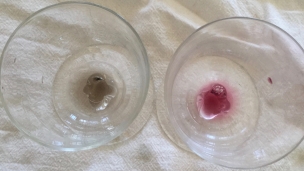 | Anthocyanins are pH sensitive, whereas betalains are stable across a
wide pH range. Pomegranate juice (left) turns grey when baking soda is
added; beet juice (right) does not.
|
Why beets have rings
The
kind of rings beets have – concentric circles of vascular tissue
alternating with storage cells – are an unusual phenomenon in flowering
plants. Radishes and turnips look a bit like beets on the outside, but
they are very typical in having only a single cylinder of vascular
tissue just below the surface to conduct water and sugar. Sometimes
this tissue gets too woody to eat and must be peeled away. Carrot roots
are almost entirely vascular tissue, with their water conducting cells
(xylem) in the center of the root axis. Ginger and turmeric have
bundles of vascular tissue scattered throughout their stems, including
in the underground stems (rhizomes) that we eat. But beet-like rings
are rare, except – you guessed it – in the order Caryophyllales.
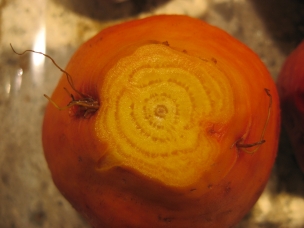
What’s
most unusual about beet rings is that each includes its own thin layer
of actively dividing cells, a vascular cambium, that spins off new
vascular tissue: xylem cells towards the inside to conduct water and
phloem cells towards the outside to conduct sugar. In the stems of
trees and most plants, there is only one vascular cambium and it
functions just under the surface. The bulk of a woody stem is dead
xylem “left behind” by the ever expanding cambium. In a beet, the
internal rings continue to make new vascular tissue. Another unusual
feature of beets is that the vascular rings alternate with wide bands
of soft sweet storage tissue made of large cells with thin walls. These
cells are packed with betalain pigments.
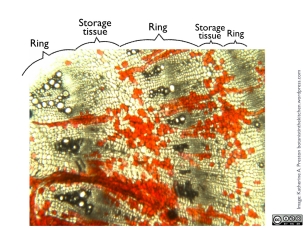
Fig. 1
Although
they are sometimes called “beetroots” (especially in England), the fat
part of a beet is anatomically part stem (hypocotyl) and part root.
These big red and golden knobs are built to store sugar that would
support a second year of growth, flowering, and seed production if we
did not harvest them first. (For an entertaining and sometimes
suspenseful description of beet reproduction, see Norm Ellstrand’s
popular books from 2003 and 2018). So what good do the rings do for the
beet? It’s not clear, but renowned wood anatomist Sherwin Carlquist has
written persuasively that they probably function extremely efficiently
in moving sugar into and then out of storage (Carlquist, 2007).
 | Fig. 2
Close up of beet vascular tissue. The center of the beetroot is towards
the upper left. Xylem is marked with an X, phloem with a P. |
He
notes that all the rings in a beet have well-developed phloem, but only
the older rings contain any xylem, suggesting that moving sugar is much
more important to beets than moving water. Other Caryophyllalean
relatives with rings, such as the climbing shrub bougainvillea, don’t
store as much sugar as beets do, and their rings include more xylem
(Carlquist, 2007).
All of the explanations above still leave us
with unanswered questions. We know that beets taste like dirt because
of geosmin, but what role does geosmin play in the life of the beet? We
can describe the anatomy and function of beet rings, but their
evolutionary origins and adaptive value in other species is still a
mystery. And a beet’s brilliant colors are due to betalains, but why do
beets favor those pigments over anthocyanins? The ancestor of all the
Caryophyllales likely stumbled upon something that worked and just ran
with it. Like many romances, it was probably a happy accident that
stuck.
It has been many years since the dirt stew incident, but
the beet goes on in marital lore. While I allowed the glaring pink
stains on the white beans to rebuke me every night for a week, my
husband didn’t complain. He just laughed and ate around the offending
beet chunks. Then he lovingly passed them over to me. No wonder there’s
a warm place in my heart for beets.
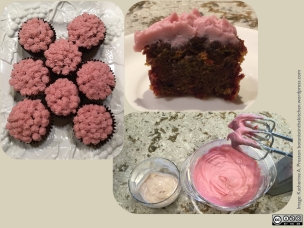 | Fig. 3
Beet cupcakes with beet-colored frosting. Anthocyanins don’t make good
food coloring; the smaller bowl of frosting was tinted with
pomegranate-blueberry juice and it’s just grey. The larger bowl
required about a teaspoon of beet juice to become bright pink. |
Valentine’s Day cupcakes with pink frosting
350º F for 18-25 mins. Makes 6-8 cupcakes
These are basically carrot cake muffins, modified for beets. They have a beet flavor, just as carrot cake has a carrot flavor.
• One very large or 2-3 medium beets
• 1/4 C plain whole fat yogurt (tart, not Greek, is best)
• 1 egg, lightly beaten
• 1/2 t vanilla extract
• grated peel of one orange
• 1/2 C sugar
• 1/2 C flour
• 1/4 t baking powder
• 1/4 t baking soda
• Half recipe of your favorite cream cheese frosting recipe
Peel
the beets (reserving peel for beet kvass, recipe below). Grate the
beets by hand into a bowl or with a food processor to make a generous
cup. (Use any extra beet in the kvass.) Extract about two teaspoons of
beet juice by using your hands to squeeze the grated beets over a sieve
set over a bowl. You may need to squeeze in batches.
Mix the
grated beets, yogurt, egg, orange peel, and vanilla extract. In another
bowl, mix the dry ingredients. Stir the dry into the wet ingredients
just until they are fully mixed. Spoon the batter into the cupcake pan
and bake.
Make half a batch of your favorite cream cheese
frosting and add drops of the extracted beet juice until you achieve
the color you desire. When the cupcakes are cool, decorate them with
pink frosting.
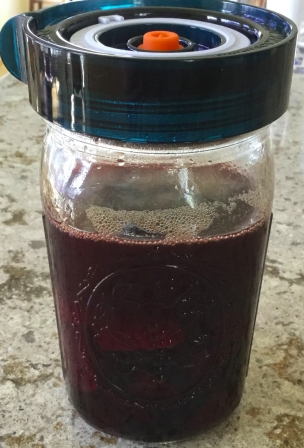
Super easy beet kvass
• Quart-size wide-mouth glass jar or fermenting crock
• One large or two small beets, preferably organic (or leftovers from cupcake recipe)
• Optional: ginger, fennel, mint, etc. Play around
• Teaspoon of salt (don’t skip! This keeps the wrong microbes at bay)
Wash
the beets just to remove dirt, but don’t peel them. The peels carry the
starting microbe culture. Chop them into large chunks and place them in
the jar with the remaining ingredients. Fill the jar with water,
leaving about an inch headspace. Cover the jar with a lid. Let the jar
sit for 5-7 days, burping it daily if you don’t have a lid with an
airlock. The kvass will be slightly fizzy. Strain out the beets and
refrigerate the kvass. Cook the beet chunks if you like.
References
Brockington,
S. F., Yang, Y., Gandia‐Herrero, F., Covshoff, S., Hibberd, J. M.,
Sage, R. F., … & Smith, S. A. (2015). Lineage‐specific gene
radiations underlie the evolution of novel betalain pigmentation in
Caryophyllales. New Phytologist, 207(4), 1170-1180.
https://nph.onlinelibrary.wiley.com/doi/full/10.1111/nph.13441
Carlquist,
S. (2007). Successive cambia revisited: ontogeny, histology, diversity,
and functional significance. The Journal of the Torrey Botanical
Society,
301-332.http://www.sherwincarlquist.com/pdf/Successive-Cambia-Revisited-Ontogeny-Histology_2007.pdf
See also (http://www.sherwincarlquist.com/successive-cambia.html)
Davies,
K. M., Albert, N. W., Zhou, Y., & Schwinn, K. E. (2018). Functions
of Flavonoid and Betalain Pigments in Abiotic Stress Tolerance in
Plants. Annual Plant Reviews, 1-41.
https://onlinelibrary.wiley.com/doi/full/10.1002/9781119312994.apr0604
Ellstrand, N. C. (2003). Dangerous liaisons?: when cultivated plants mate with their wild relatives. JHU Press.
Ellstrand,
N. C. (2018). Sex on the Kitchen Table: The Romance of Plants and Your
Food. University of Chicago Press.
https://www.press.uchicago.edu/ucp/books/book/chicago/S/bo28638736.html
Gerber,
N. N., & Lechevalier, H. A. (1965). Geosmin, an earthy-smelling
substance isolated from actinomycetes. Applied microbiology, 13(6),
935-938. https://www.ncbi.nlm.nih.gov/pmc/articles/PMC1058374/
Lopez‐Nieves,
S., Yang, Y., Timoneda, A., Wang, M., Feng, T., Smith, S. A., … &
Maeda, H. A. (2017). Relaxation of tyrosine pathway regulation
underlies the evolution of betalain pigmentation in Caryophyllales. New
Phytologist, 217(2), 896-908.
https://nph.onlinelibrary.wiley.com/doi/full/10.1111/nph.14822
Maher,
L., & Goldman, I. L. (2017). Bidirectional recurrent half-sib
family selection for geosmin concentration in table beet. Crop Science,
57(5), 2564-2574.
https://dl.sciencesocieties.org/publications/cs/abstracts/57/5/2564
Maher,
L., & Goldman, I. L. (2018). Endogenous Production of Geosmin in
Table Beet. HortScience, 53(1),
67-72.http://hortsci.ashspublications.org/content/53/1/67.abstract
Osbourn, A. (2017). Painting with betalains. Nature plants, 3(11), 852.https://www.nature.com/articles/s41477-017-0049-x
Polturak,
G., Grossman, N., Vela-Corcia, D., Dong, Y., Nudel, A., Pliner, M., …
& Aharoni, A. (2017). Engineered gray mold resistance, antioxidant
capacity, and pigmentation in betalain-producing crops and ornamentals.
Proceedings of the National Academy of Sciences, 114(34),
9062-9067.https://www.pnas.org/content/114/34/9062.full
|
|








